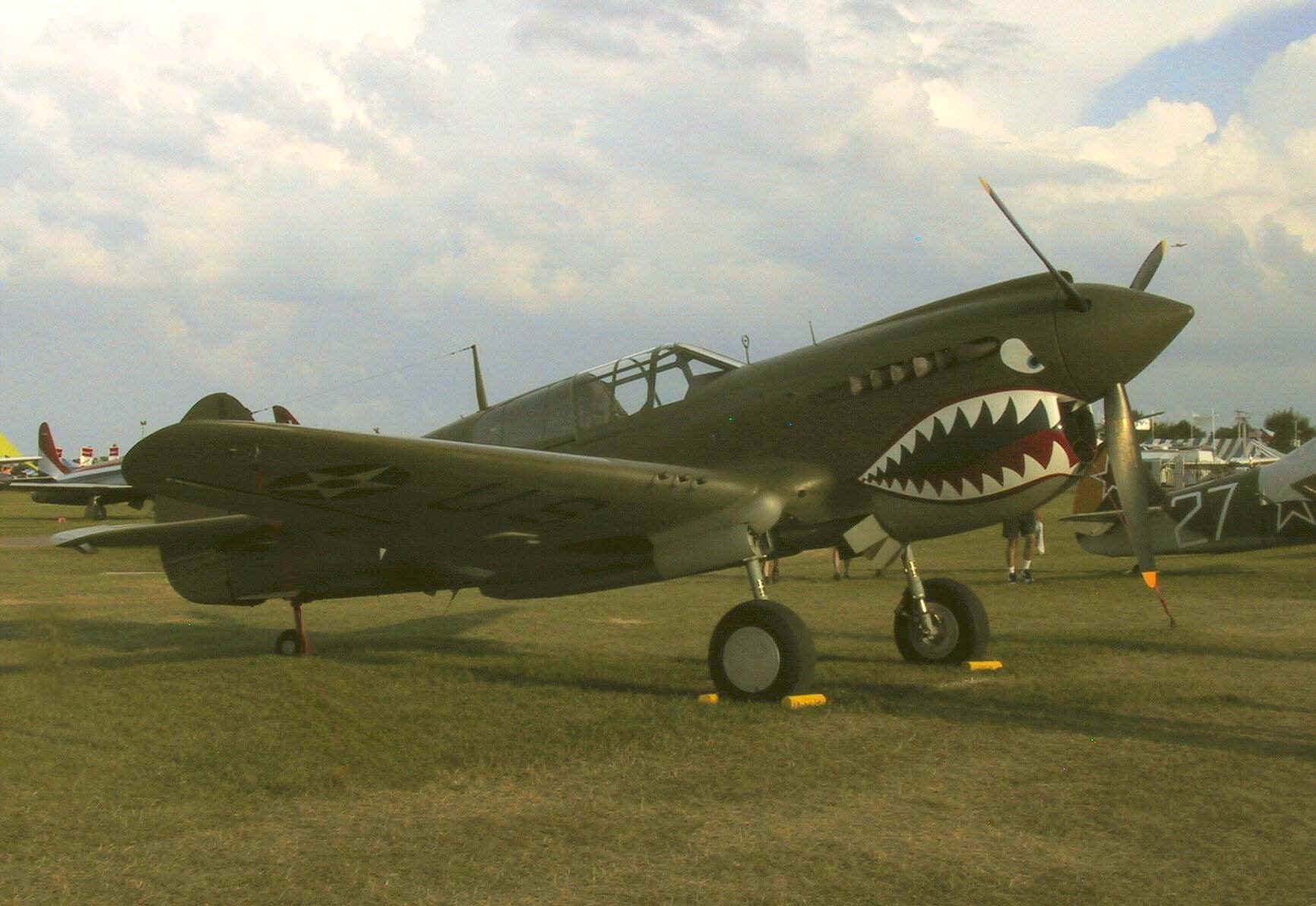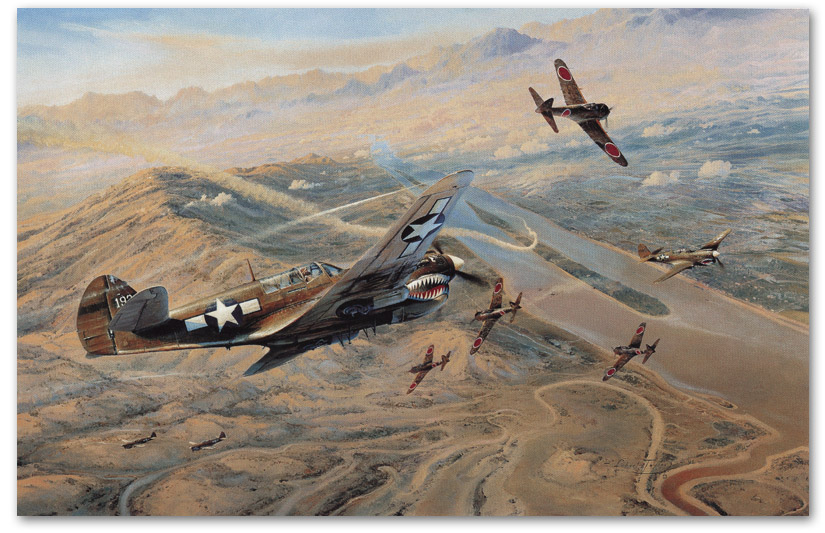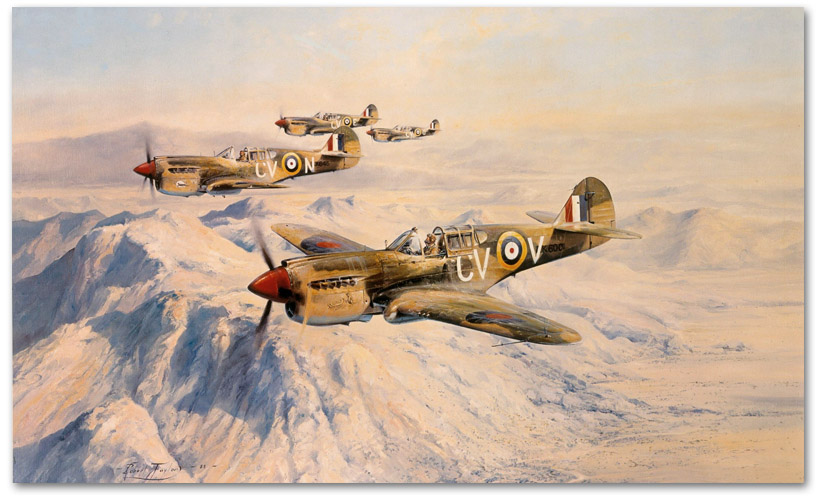|
Air Power |
The Curtiss P-40 was undoubtedly one of the most controversial fighters to serve in quantity during the Second World War. It was praised and abused, lauded and vilified, but the fact remains that, as the first American single-seat fighter to be manufactured on a mass-production basis, it bore much of the brunt of the air warfare over several battle fronts. Its performance was inferior to the performances of the majority of its antagonists, but this shortcoming was partly compensated for by its tractability and its sturdiness which enabled it to withstand a considerable amount of punishment. It was amenable to adaptation and it was available when most sorely needed.
Not particularly good technically or in performance, though very durable, P-40s continued to be produced until the end of 1944, serving also with air force units of Turkey, South Africa, Canada, Australia and New Zealand. Later versions were known as Kittyhawks to the RAF and its Allies. Not usually realized is that the name Warhawk applied only to the United States Army Air Force P-40s starting with the P-40F version, a much improved plane with a license built version of the British Rolls-Royce Merlin engine installed.
The belief in the "ascendancy of bombardment over pursuit" was rife in 1937 when the Curtiss P-40 was first envisaged, and it is a sobering thought that, with the Bell P-39 Airacobra this product of such a school of thought constituted more than half the strength of all USAAF fighters until July 1943. Prior to September of that year the P-39 and P-40 also comprised more than half the USAAF fighters committed overseas. However, by July 1945 only one P-40 group remained operational.
The prototype P-40 took to the air in the autumn of 1938, and production was initiated in the following year. Performance of the first version of this single-seat fighter had not really come up to expectations, but as several air forces were desperate for new aircraft, the type was welcomed into service. The US had delayed modernizing its Army Air Service until the last minute, so P-40s made up a large part of their equipment during the first years of war. Britain and France also ordered P-40s to contend with the German Luftwaffe, but in the case of France, deliveries came too late and their P-40s were diverted to the Royal Air Force - to be known as Tomahawks. Similarly, the Soviet Union's outdated air force had fared badly at the hands of the Germans, and P-40s were also sent there.
The P-40 was initially designed around the Allison V-1710 liquid-cooled inline engine which offered better streamlining, more power per unit of frontal area, and better specific fuel consumption than did air-cooled radials of comparable power. Unfortunately, the rated altitude of the Allison engine was only some 12,000 feet, rendering combat above 15,000 feet a completely impracticable proposition. The P-40's ancestry dated back as far as 1924; the famed Curtiss Hawk fighters being in the forefront of all US warplanes. But its development was hindered from the start. The overall limitations of its design were such that the addition of multi-speed superchargers was considered inadvisable in view of the pending production of superior fighter designs. The achievements of the P-40 were therefore all the more creditable.
The prototype XP-40, the Curtiss Hawk Model 81, owed its origin to the earlier Model 75 of 1935 vintage. With the standardization of the Allison V-1710 , the P-36 design was reworked to incorporate this engine, becoming the XP-37 which was equipped with a General Electric turbo-supercharger, and featured numerous other modifications, including a rearward positioned cockpit. Thirteen YP-37s were built for service evaluation; but, with increasingly ominous signs of an approaching war, development of this fighter was abandoned in favor of a less complex and more direct conversion of the P-36 for the Allison engine, the XP-40. This was, in fact, the tenth production P-36A with an integrally-supercharged 1,160 h.p. Allison V-1710-19 (C13) engine, and first flew with its new power plant in the autumn of 1938. Successful in a US Army Pursuit Contest staged at Wright Field, in May 1939 it was awarded what was at that time the largest-ever production order for a US fighter, totaling nearly thirteen million dollars.
The P-40 was a relatively clean design, and was unusual for its time in having a fully retractable tail wheel. One hundred and ninety-seven P-40s were built in 1939-40 for the USAAF, and many more were sold abroad to Britain and France. In the RAF, which service purchased 140 outright, it was known as the Tomahawk Mk. I, IA, and IB, and carried two .303 in. Browning machine-guns in place of the 0.30in.-calibre guns fitted in USAAF machines. It retained the standard synchronized armament of two 0.5 in.-calibre machine-guns in the top nose decking.
The Flying Tigers
Many US volunteer pilots flew on behalf of Britain, the Soviet Union and China before the United States entered the war. A group of them, equipped with P-40s, went to help the Chinese in their struggle against the Japanese in 1942, where they became known as the 'Flying Tigers' because of their uniquely painted aircraft. This group later became part of the USAAF proper, and P-40s were thereafter used widely in the Pacific.
In the middle of 1941 General Claire Chennault began recruiting for his Volunteer Group--better known as the Flying Tigers--to fight the Japanese from China, for which 100 P40s were ordered for purchase through a loan from the US Government. Ninety aircraft, mostly P-40Bs, were actually delivered, sufficient for three squadrons, plus a few spares. At the time of the USA's entry into the war there were eighty American pilots in the Volunteer Group, and shortly after arriving at Kunming the P-40s drew first blood, six out of ten attacking Japanese bombers being destroyed by two of the AVG squadrons on December 20. There were no American casualties on this occasion, but the third squadron, left behind at Mingaladon, Burma, was less fortunate, and lost two pilots on their first interception, on December 23,1941. The American pilots had underestimated the maneuverability of the lightly built Japanese Zero fighters, and failed to utilize their superior speed and diving ability to advantage. It was soon the cardinal rule that a P-40 should always avoid mixing it individually with a Japanese fighter, owing to the Curtiss machine's inferior climb rate and maneuverability, but the P-40 substantiated a reputation for ruggedness that it was already acquiring with the RAF in the Middle East, and its armor protection saved many AVG pilots in subsequent combat.
Both the Flying Tigers in China and the RAF squadrons in the Middle East had their P-40Bs replaced by P-40Es. The AVG after continuous operation, was down to some twenty P-40Bs by March 1942, when some thirty P-40Es were ferried to China by air from Accra, in Africa. The improved performance offered by these more potent P-40s was found to be extremely valuable against the Mitsubishi A6M Zero-Sen fighters which, first introduced in the Chinese theatre in 1940, were becoming increasingly numerous. The ground-attack potential of the P-40E was also much superior. The AVG pilots had resorted to carrying 30-lb. incendiary and fragmentation bombs in the flare chutes of their P-40Bs, but it was questionable whether this was not more hazardous to the attackers than to the attacked. But some indication of the P-40's capabilities in resolute hands is given by the fact that from its inception in December 1941 until July 4, 1942, when it was absorbed by the USAAF, the AVG was officially credited with the destruction of 286 Japanese aircraft for the loss of eight pilots killed in action, two pilots and one crew chief killed during ground attack, and four pilots missing. The top-scoring AVG pilot, Robert H. Neale, was credited with the destruction of sixteen enemy aircraft while flying the P-40, and eight other pilots claimed ten or more victories.
One of the most significant steps in P-40 development came in 1941, when a British-built Rolls-Royce Merlin 28 engine with a single-stage, two-speed supercharger was installed in a Kittyhawk I airframe to improve its high-altitude performance. The Curtiss H-87-D, or XP-40F, as the Merlin-powered prototype became known, then had 1,300 hp available for takeoff, and 1,120 hp at 18,500 feet, which offered vast improvements over earlier models and endowed a maximum speed of 373 mph. This was reduced slightly in the YP-40F, which, like later variants, had the Packard-built Merlin V-1650-1 and revised cooling, the air intake above the cowling being incorporated in the radiator scoop. Gross weight climbed to 9,870 lb.
Following experiments in cooling-drag reduction in 1943 with a P-40K-10-CU which had its "beard" radiator removed to wing installations, and in rear vision improvements by installing a "bubble" canopy on a standard P-40L, a general " clean-up " programme was initiated, resulting in the sole XP-40Q. With a 1,425 hp Allison V-1710-121 engine, the XP-40Q was modified from the first P-40K-I to have a "bubble" canopy and cut-down rear fuselage, wing radiators and, eventually, clipped wing tips. A four-blade propeller was fitted, and water injection installed. With a weight of only 9,000 lb, the XP40Q attained a maximum speed of 422 mph. This was still less than the speed attained by contemporary production Mustangs and Thunderbolts , however, and the XP-40Q did not achieve production.
Specifications:
Manufacturer: Glenn H. Curtiss Aviation
Primary Role: Fighter
Crew: One
Powerplant: One Allison V-1710-99 , Vee - 12 cylinder, liquid cooled engines.
Engine power: 1,200 h.p. @ takeoff and 1,125 h.p. @ 17,300 ft. with a single speed supercharger.
Cost: $45,000
Number Built: Approximately 15,000
Number Still Airworthy: 19
Dimensions:
Wing span: 37 ft. 4 in.
Length: 33 ft. 4 in.
Height: 12 ft. 4 in.
Weights: Empty: 6,700 lb. / Operational: 8,400 lb. / Max Takeoff: 11,400 lbs
Performance:
Maximum Speed: 325 m.p.h. @ 25,000 ft. / 343 m.p.h. @ 15,000 ft. / 308 m.p.h. @ 5,000 ft.
Cruising Speeds: 235 mph
Service Ceiling: 30,000 ft.
Range: 750 miles @ 10,000 ft. ft.
Max. Range: 2,800 miles @ 10,000 ft.
Armaments:
Six 0.5-in. Browning machine-guns with 281 rpg
External bomb load of three 500-lb. bombs.









Hap Arnold and Claire Chennault, Curtiss P-40s, Chungking, ca. 1942:
All information and photos Copyright of Aviation History.com and Glenn H. Aviation.com




